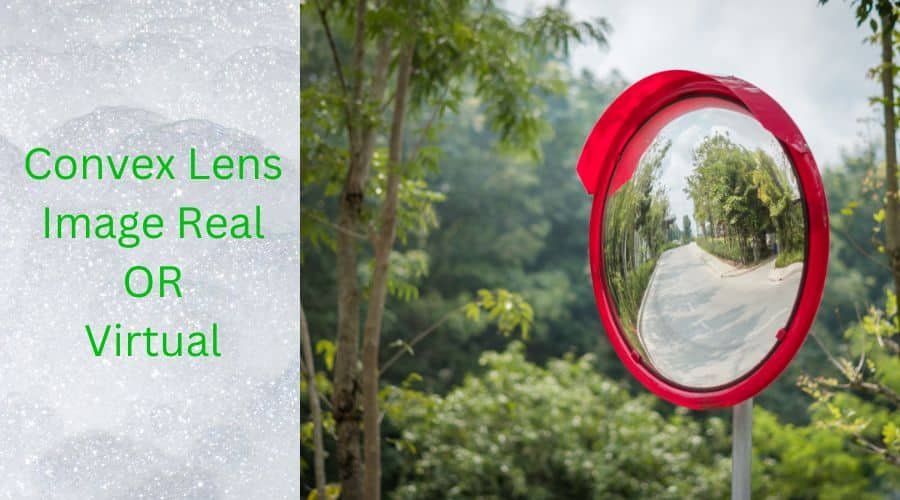Convex lenses, commonly known as converging lenses, are essential components in various optical instruments such as cameras, microscopes, eyeglasses, and telescopes. Their unique shape, thicker in the middle and thinner at the edges, allows them to bend light rays inward, causing them to converge at a point called the focal point. This capability makes convex lenses crucial for forming images, which can either be real or virtual depending on the object’s distance from the lens. Real images, which are inverted and can be projected onto a surface, and virtual images, which are upright and only visible through the lens, are fundamental concepts in optics.
Convex lenses play a significant role in everyday technology and scientific devices, making it important to understand how they work and the types of images they produce. This article explores the principles behind Convex Lens Image Real or Virtual, their image-forming abilities, and their wide-ranging practical applications.
You May Also Read: Camera Lenses For Beginners
Convex Lenses: An Overview
Definition and Structure:
A convex lens is a transparent optical device with at least one outward-curving surface, thicker in the middle than at the edges. Its main function is to bend light rays inward, causing them to converge at a focal point. This ability to focus light is essential for forming images, making convex lenses key components in devices such as cameras, microscopes, and eyeglasses. Convex lens capacity to create real or virtual images depends on the position of the object relative to the lens.
Types of Convex Lenses:
Convex lenses can be categorized into three main types based on their curvature:
1: Plano-Convex Lens: This lens has one flat surface and one convex (outward-curved) surface. It is commonly used to focus light in optical systems like lasers and cameras.
2: Bi-Convex (Double Convex) Lens: Both surfaces of this lens are convex. It is widely used in imaging devices such as magnifying glasses and microscopes to form real, focused images.
3: Meniscus Convex Lens: This lens has one convex surface and one concave (inward-curved) surface, with the convex side being more pronounced. It is often used in eyeglasses and optical systems to reduce distortion and improve image quality.
Basic Properties:
Convex lenses exhibit several fundamental properties that govern their behaviour with light:
- Focal Point (F): This is the point where parallel rays of light converge after passing through the lens. The focal point is crucial for focusing light to form images.
- Focal Length (f): The distance between the centre of the lens and the focal point. A shorter focal length means stronger convergence of light rays and a longer focal length results in weaker convergence.
- Optical Axis: An imaginary line that passes through the centre of the lens and extends through its two focal points. It serves as the reference for light rays passing through the lens.
- Principal Axis: The primary axis through the centre of the lens along which light is most efficiently focused.
Image Formation by Convex Lenses
The nature of the image formed by a convex lens depends on the position of the object relative to the lens and its focal points. To understand this, it’s essential to consider different object positions:
1. Object at Infinity:
When an object is placed at a great distance (essentially infinity) from the convex lens, the rays of light coming from the object are parallel to each other. After passing through the lens, these rays converge at the focal point on the other side of the lens.
- Image Characteristics:
- Position: At the focal point (F).
- Nature: Real and inverted.
- Size: Highly diminished.
2. Object Beyond the Center of Curvature (C):
If the object is placed beyond the centre of curvature, which is twice the focal length from the lens:
- Image Characteristics:
- Position: Between the focal point (F) and the centre of curvature (C) on the opposite side of the lens.
- Nature: Real and inverted.
- Size: Diminished.
3. Object at the Center of Curvature (C):
When the object is exactly at the centre of curvature:
- Image Characteristics:
- Position: At the centre of curvature on the opposite side of the lens.
- Nature: Real and inverted.
- Size: Same size as the object.
4. Object Between the Center of Curvature (C) and the Focal Point (F):
If the object is positioned between the centre of curvature and the focal point:
- Image Characteristics:
- Position: Beyond the centre of curvature on the opposite side.
- Nature: Real and inverted.
- Size: Magnified.
5. Object at the Focal Point (F):
When the object is placed at the focal point:
- Image Characteristics:
- Position: At infinity.
- Nature: Real and inverted.
- Size: Highly magnified.
6. Object Between the Focal Point (F) and the Lens:
If the object is placed between the focal point and the lens:
- Image Characteristics:
- Position: On the same side of the lens as the object.
- Nature: Virtual and upright.
- Size: Magnified.
Real vs. Virtual Images
Real Images:
A real image is formed when light rays converge and meet at a point after passing through the lens. These images can be projected onto a screen because they exist at a certain location in space.
- Characteristics:
- Formed on the opposite side of the lens from the object.
- Always inverted relative to the object.
- Can be captured on a screen or photographic film.
Virtual Images:
A virtual image, on the other hand, is formed when light rays diverge, and the extensions of these diverging rays appear to converge on the same side of the lens as the object. Virtual images cannot be projected onto a screen because they do not exist at a real point in space; they are perceived by the observer’s eye.
- Characteristics:
- Formed on the same side of the lens as the object.
- Always upright relative to the object.
- Cannot be captured on a screen; visible only when looking through the lens.
Mathematical Representation of Image Formation
The relationship between the object distance (u), the image distance (v), and the focal length (f) of a convex lens is given by the lens formula:
1f=v1−u1
Where:
- f is the focal length of the lens.
- v is the image distance from the lens.
- u is the object’s distance from the lens.
This formula helps in calculating the position and nature of the image formed by the convex lens.
Magnification:
Magnification (M) is a measure of how much larger or smaller the image is compared to the object. It is given by:
M=hohi=uv
Where:
- M is the magnification.
- hi is the height of the image.
- ho is the height of the object.
- v is the image distance.
- u is the object distance.
A positive magnification indicates an upright image, while a negative magnification indicates an inverted image.
Applications of Convex Lenses
Convex lens are used in a variety of applications due to their ability to form both real and virtual image. Some of the most common applications include:
1. Eyeglasses
Convex lenses are used in eyeglasses for people with hyperopia (farsightedness) to converge light rays before they enter the eye, helping focus images on the retina.
2. Cameras
Camera lenses often include convex elements to focus light onto the camera’s sensor, producing clear and sharp images. Different focal lengths are used to achieve various levels of magnification and field of view.
3. Microscopes
In microscopes, convex lenses are used to magnify small objects, allowing detailed observation of tiny details that are invisible to the naked eye. The objective lens forms a real, inverted image, which is then magnified by the eyepiece to produce a virtual image.
4. Telescopes
Telescopes use convex lenses to gather and focus light from distant objects, such as stars and planets, making them appear larger and closer. The objective lens forms a real image, which is then viewed through an eyepiece that creates a virtual image for the observer.
5. Magnifying Glasses
A magnifying glass is a simple convex lens used to produce a virtual, enlarged image of an object when placed close to it. This is useful for reading small text or examining small objects.
Practical Considerations in Using Convex Lenses
When using convex lenses in practical applications, several factors need to be considered to ensure optimal performance:
1. Lens Quality
The quality of the lens material and its manufacturing process affect image clarity and sharpness. High-quality lenses minimize aberrations and distortions.
2. Coatings
Anti-reflective coatings reduce glare and improve light transmission, enhancing image quality. These coatings are particularly important in photography and precision instruments.
3. Alignment
Proper alignment of the lens is crucial for accurate image formation. Misalignment can result in blurred or distorted images.
4. Cleaning and Maintenance
Regular cleaning and maintenance of lenses are necessary to prevent dust and smudges from affecting image quality. Use appropriate cleaning solutions and tools to avoid damaging the lens surface.
Conclusion
Convex lenses are powerful optical devices that play a crucial role in various fields, from everyday vision correction to advanced scientific research. Understanding the principles of how convex lenses form real and virtual images allows us to harness their capabilities effectively. Whether in eyeglasses, cameras, microscopes, or telescopes, convex lenses continue to be indispensable tools in our quest to see and understand the world more clearly. By exploring their properties and applications, we gain a deeper appreciation for the science of optics and its impact on our daily lives.
Click: Can Camera Lenses Be Repaired?
FAQs
1. What is a convex lens?
A convex lens is a type of optical lens that is thicker in the middle than at the edges, causing light rays to converge at a focal point.
2. How does a convex lens form a real image?
A real image is formed when light rays converge and meet at a point after passing through a convex lens, resulting in an inverted image that can be projected onto a screen.
3. What is a virtual image in a convex lens?
A virtual image is formed when light rays diverge after passing through a convex lens, appearing to converge on the same side as the object. It is upright and cannot be projected.
4. Why is focal length important in convex lenses?
The focal length determines the lens’s ability to converge light. It affects the magnification and the distance at which the image is formed relative to the lens.
5. What are the common applications of convex lenses?
Convex lenses are used in eyeglasses, cameras, microscopes, telescopes, and magnifying glasses to focus light, correct vision, and magnify images for detailed observation.

